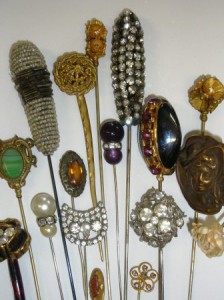 Did you know that in 1903 an English judge ordered a group of women to remove their hatpins and hats because he feared they may use them as weapons? The women were on trial for campaigning for the right to vote. By 1909, the Illinois and Arkansas legislatures established laws mandating that women acquire permits if they wished to wear hat pins longer than 9 inches. The pins were considered deadly weapons. Many ladies had to cut their pins in order to wear them in public. By 1910, to ensure that people were not accidently hurt, special ordinances were passed requiring hatpin tips to be covered.
Did you know that in 1903 an English judge ordered a group of women to remove their hatpins and hats because he feared they may use them as weapons? The women were on trial for campaigning for the right to vote. By 1909, the Illinois and Arkansas legislatures established laws mandating that women acquire permits if they wished to wear hat pins longer than 9 inches. The pins were considered deadly weapons. Many ladies had to cut their pins in order to wear them in public. By 1910, to ensure that people were not accidently hurt, special ordinances were passed requiring hatpin tips to be covered.
Over the years hatpins have proven to be both necessary and fashionable.
Hat pins actually date back as far as the Middle Ages. In Europe, proper ladies used the pins to secure their veils and wimples to keep their hair hidden. Pins were used this way for hundreds of years.
By the 1800’s, hat pin making had become a cottage industry which often included the entire family. By the 1820’s in Britain, demand for the hatpins outgrew the number that could be made by hand. As a result Britain began importing them from France. The British Parliament became concerned at the effect the imports were having and ended up restricting the sale of hatpins to two days a year, January 1st and 2nd. Queen Victoria taxed her people at the beginning of each year to pay for her hatpins .This left only the wealthy able to obtain these unique handmade pins. Prior to the 1830’s, theft of a handmade hatpin was punishable by hanging. In 1932, a hatpin making machine was invented in America.
It was in the 1880’s when hatpins really became a necessary accessory. Bonnets gave way to hats. The hats became bigger and bigger as fashions changed causing the popularity of hatpins to soar. Hatpins stayed popular until WWII when women began filling the jobs once occupied by men. Hats were impractical in factory conditions and soon fell out of fashion.
Collecting hatpins can be a fun hobby and a great way to learn a bit of history. Earliest hatpins were simple metal skewers. Later they were made with silver stems topped with gems, ivory, pearl, sea shells, buttons, glass and more. As always, do your research before starting any serious collection.
Find hatpins and hatpin holders at Albany Antique Mall. Open daily at 2nd and Ellsworth in historic downtown Albany.
